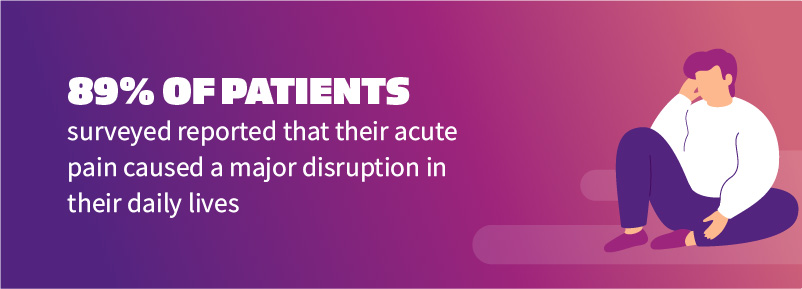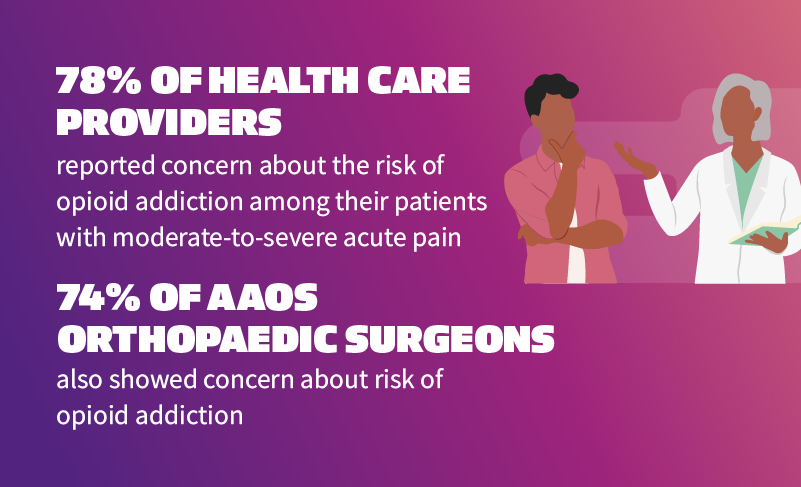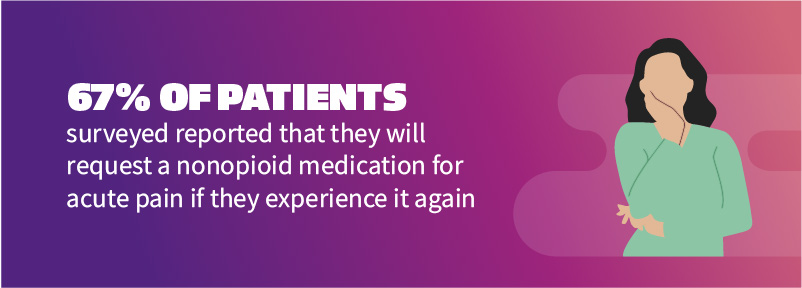Pain is an experience that transcends physical discomfort. It has the potential to affect every aspect of a person’s life, including disrupting one’s daily routine, hindering professional commitments, and negatively impacting emotional well-being.i It is also one of the most common reasons that people visit the doctor.
An estimated 80 million adults receive medicine for acute pain in the U.S. each year, which is defined as pain lasting up to three months.ii,iii It typically starts suddenly and is often caused by something specific, such as an injury or a surgery, but inadequately managed acute pain can lead to a significant decline in a person’s quality of life.i,iv,v
Approximately 40 million Americans with acute pain are prescribed an opioid to manage their discomfort each year.vi Although opioids can be effective, they also carry a labeled risk of addiction.vii In fact, roughly 85,000 U.S. adults are expected to develop opioid use disorder (OUD) within a year of their prescribed treatment of acute pain.vi
To better understand the perceptions and experiences of patients and health care providers dealing with acute pain today, we launched a nationwide survey.
Vertex Pharmaceuticals conducted a double-blinded, quantitative survey in June 2024 that collected data from a diversified sample of 1,001 adults (ages 18+) in the United States who were treated for acute pain in the 12 months prior and 547 health care providers who treated the condition in the month prior.viii To further recognize the complexities of treating acute pain, Vertex commissioned the American Academy of Orthopaedic Surgeons (AAOS) to conduct a separate survey among its membership of orthopaedic surgeons who are on the frontlines of pain management.ix The sample included 49 U.S. surgeon members of AAOS who treated patients with moderate-to-severe acute pain over the course of two weeks in August–September 2024.ix [Note: Survey methodology details for both surveys are noted below.]
The survey results revealed that patients, health care providers and AAOS orthopaedic surgeon respondents have complex considerations when it comes to acute pain.viii,ix

viii
The limitations patients surveyed experienced due to acute pain in the last year included daily tasks like walking or exercise (70%) and engaging in hobbies or leisure activities (65%).viii Their responses also indicated that acute pain transcends physical symptoms and can impact emotional well-being—69% of patients surveyed reported trouble sleeping and 65% reported feeling emotionally drained or irritable.viii
77% of health care providers surveyed reported that they face challenges when treating patients with moderate-to-severe acute pain.viii

viii,x
~88% of health care providers surveyed reported that the risk of side effects limits their ability to adequately treat their patients with moderate-to-severe acute pain.viii

viii
The Vertex and AAOS surveys underscore that treating acute pain in today’s health care landscape can be complex, as are the complexities that patients and health care providers have when personalizing pain management.ix,viii
Vertex Pharmaceuticals Survey Methodology: The national survey, conducted by Vertex Pharmaceuticals in June 2024, collected responses from 1,001 U.S. adults ages 18+ who were treated for moderate-to-severe acute pain in the 12 months prior and 547 health care providers who treated moderate-to-severe acute pain in the month prior.viii The quantitative survey was conducted in a double-blinded manner to minimize bias and ensure objectivity.viii Participants were recruited from a panel who consented to participate in market research and were paid for their time.viii The survey ensured a diversified sample of participants across demographics and other characteristics.viii Findings were initially shared in October 2024.
American Academy of Orthopaedic Surgeons (AAOS) Survey Methodology: The AAOS conducted a separate, single-blinded survey using a subset of 12 questions from the Vertex Pharmaceuticals health care provider survey. The sample included 49 U.S. surgeon members of AAOS who treated patients with moderate-to-severe acute pain over the course of two weeks in August–September 2024.ix
[i] Sinatra R. Causes and consequences of inadequate management of acute pain. Pain Med. 2010;11(12):1859-1871. doi:10.1111/j.1526-4637.2010.00983.x
[ii] Banerjee S, Argáez C. Multidisciplinary treatment programs for patients with acute or subacute pain: a review of clinical effectiveness, cost-effectiveness, and guidelines. Canadian Agency for Drugs and Technologies in Health. 2019. PMID: 31498579
[iii] Lopez A, Jones J, Menzie AM, Peta S, Ippolito A, Rubin J. An evaluation of the prevalence of acute and chronic pain medication use in the United States: a real-world database analysis. Presented at: ASRA Annual Pain Medicine Meeting; November 10-11, 2023; New Orleans, LA.
[iv] Data on file. Vertex Pharmaceuticals Incorporated. Boston, MA. REF-24709 (v1.0); 2024.
[v] Katz N. The impact of pain management on quality of life. J Pain Symptom Manage. 2002;24(suppl 1):S38-S47. doi:10.1016/s0885-3924(02)00411-6
[vi] Data on file. Vertex Pharmaceuticals Incorporated. Boston, MA. REF-25086 (v4.0); 2024.
[vii] Blondell RD, Azadfard M, Wisniewski AM. Pharmacologic therapy for acute pain. Am Fam Physician. 2013;87(11):766-772. https://www.aafp.org/pubs/afp/issues/2013/0601/p766.html
[viii] Data on file. Vertex Pharmaceuticals Incorporated. Boston, MA. REF-26477 (v1.0); 2024.
[ix] Data on file. Vertex Pharmaceuticals Incorporated. Boston, MA. REF-27351 (v1.0); 2024.
[x] Data on file. Vertex Pharmaceuticals Incorporated. Boston, MA. REF-27113 (v1.0); 2024.

